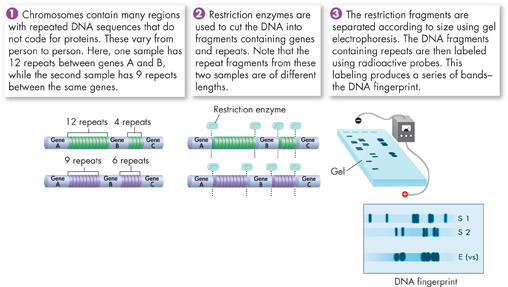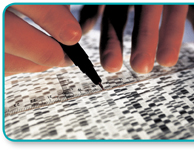
FIGURE 15–19 Identifying Individuals DNA fingerprinting can be used to determine a person's identity. It is especially useful in solving crimes. The diagram above shows how scientists match DNA evidence from a crime scene with two possible suspects. Interpret Graphics Does the DNA fingerprint above match suspect 1 (S1) or suspect 2 (S2)? How can you tell?
dPersonal Identification
 How is DNA used to identify individuals?
How is DNA used to identify individuals?
The complexity of the human genome ensures that no individual is exactly like any other genetically—except for identical twins, who share the same genome. Molecular biology has used this fact to develop a powerful tool called DNA fingerprinting for use in identifying individuals.  DNA fingerprinting analyzes sections of DNA that may have little or no function but that vary widely from one individual to another. This method is shown in Figure 15–19. First, restriction enzymes cut a small sample of human DNA. Next, gel electrophoresis separates the restriction fragments by size. Then, a DNA probe detects the fragments that have highly variable regions, revealing a series of variously sized DNA bands. If enough combinations of enzymes and probes are used, the resulting pattern of bands can be distinguished statistically from that of any other individual in the world. DNA samples can be obtained from blood, sperm, or tissue—even from a hair strand if it has tissue at the root.
DNA fingerprinting analyzes sections of DNA that may have little or no function but that vary widely from one individual to another. This method is shown in Figure 15–19. First, restriction enzymes cut a small sample of human DNA. Next, gel electrophoresis separates the restriction fragments by size. Then, a DNA probe detects the fragments that have highly variable regions, revealing a series of variously sized DNA bands. If enough combinations of enzymes and probes are used, the resulting pattern of bands can be distinguished statistically from that of any other individual in the world. DNA samples can be obtained from blood, sperm, or tissue—even from a hair strand if it has tissue at the root.

Forensic Science DNA fingerprinting has been used in the United States since the late 1980s. Its precision and reliability have revolutionized forensics—the scientific study of crime scene evidence. DNA fingerprinting has helped solve crimes, convict criminals, and even overturn wrongful convictions. To date, DNA evidence has saved more than 110 wrongfully convicted prisoners from death sentences.
DNA forensics is used in wildlife conservation as well. African elephants are a highly vulnerable species. Poachers, who slaughter the animals mainly for their precious tusks, have reduced their population dramatically. To stop the ivory trade, African officials now use DNA fingerprinting to identify the herds from which black-market ivory has been taken.
 In Your Notebook Describe the process of DNA fingerprinting.
In Your Notebook Describe the process of DNA fingerprinting.

Table of Contents
- Formulas and Equations
- Applying Formulas and Equations
- Mean, Median, and Mode
- Estimation
- Using Measurements in Calculations
- Effects of Measurement Errors
- Accuracy
- Precision
- Comparing Accuracy and Precision
- Significant Figures
- Calculating With Significant Figures
- Scientific Notation
- Calculating With Scientific Notation
- Dimensional Analysis
- Applying Dimensional Analysis




